Experience into dance: translation and failure
Andrew Fuhrmann, Dance Massive 2017
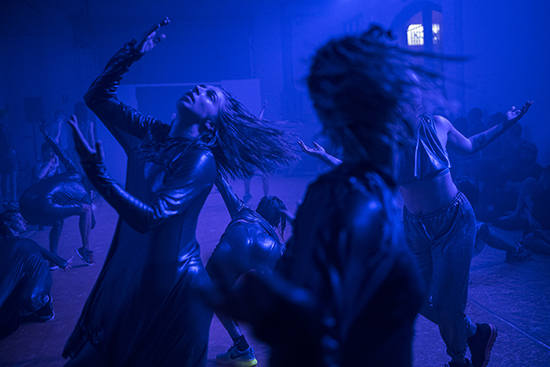
Deep Sea Dances, Rebecca Jensen and ensemble, Dance Massive 2017
photo Gregory Lorenzutti
Deep Sea Dances, Rebecca Jensen and ensemble, Dance Massive 2017
The American writer Claudia La Rocco, currently a columnist for Artforum, was in Melbourne recently as a guest of Dancehouse, running a series of workshops on writing and performance.
In The Best Most Useless Dress, a collection of her essays, reviews and hybrid responses, there is a long essayistic poem called “On Taste” which describes her participation in a collaborative dance performance that premiered at the BFI Gallery in Miami in 2012. It opens with these lines:
The carpet is impossibly white?
The tower is a double crescent
There is a way in which the translator must love failure?
The thin line of light splitting the morning sky
Certainly critics must be, on some level, fascinated with the difficulty of translating the experience of a performance into words. This is uncontroversial. But what about choreographers? Is the love of failure the same? Are they, too, driven by the impossibility of a perfect translation from life into art?
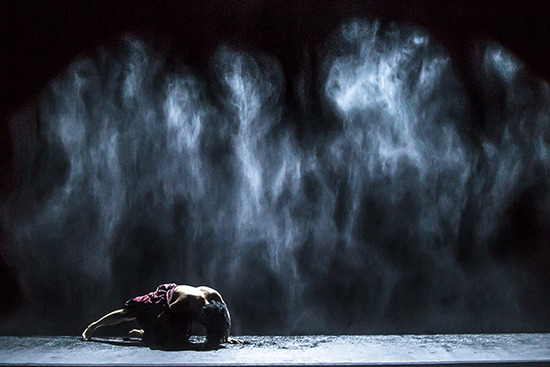
Tangi Wai, Victoria Hunt, Dance Massive 2017
photo Bryony Jackson
Tangi Wai, Victoria Hunt, Dance Massive 2017
Victoria Hunt, Tangi Wai…The Cry of the Water
Tangi Wai is a dim and distant and sometimes disappearing work. Everything happens in darkness and a long way from the audience. This could signal a kind of emergence, as though the Maori mythology and cosmology invoked by director and choreographer Victoria Hunt were rising from the deep past into the present; but it could equally be the opposite, a mourning song for old spirits now departed.
Everything here is so indistinct and overshadowed that either reading is possible. This is a work which demands a speculative leap to finish the translation.
It begins with a complete blackout. Then there is a single white light, some 30 metres away at the other end of the vast Meat Market pavilion. More lights begin to flicker around the space. There is a low rumble, which slowly builds in intensity. Eventually, we see a woman in the distance, surrounded by clouds of watery mist, long bars of white light sliding over her and moving toward the audience.
At this point Tangi Wai begins to look like a kind of birth story. The woman thrashes around, partially naked, a kinetic solo suggesting either ecstasy or agony. The bands of light come faster and faster, like peristaltic contractions. We glimpse something that might be an umbilical cord—and then there is more darkness. In the next scene, a new dancer creeps mouse-like across the stage, zigzagging toward the audience. Is this the child that was promised?
The program notes provide some insight into the kind of traditional materials that Victoria Hunt is working with. Under the heading “Progeny,” she writes:
Lifting out of the bones, flesh and
skin like thin streams of mist,
floating into the atmosphere.
The terrifying and merciful portal
of Hine-nui-te-po.
Hine-nui-te-po, goddess of night and earth, is the ruler of the underworld in Maori mythology. The note doesn’t clarify the spectacle, but it does suggest something of the great mystery that stands between the mythology and our sense of Hunt’s stage translation.
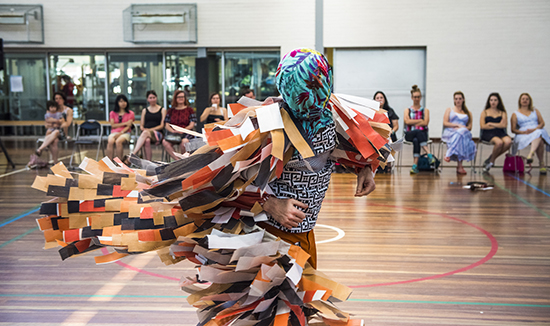
Creature, József Trefeli and Gábor Varga, Dance Massive 2017
photo Gregory Lorenzutti
Creature, József Trefeli and Gábor Varga, Dance Massive 2017
József Trefeli and Gábor Varga, Creature
Stomp. Ting. Stomp. Ting. In they come, József Trefeli and Gábor Varga, wearing big black pumps with little bells on them. The audience sits in a square around them. Immediately, the two performers begin arranging and rearranging various accessories used in traditional European folk dances, including long sticks and stock whips, creating runic figures at the centre of the square.
As they work they also dance, with much energetic stamping and scuffing and clapping.
All this is a long—but delightful—prelude to the revelation of two creatures. It is a costume transformation. Trefeli and Varga climb into matching bodysuits covered with short streamers and place long brown cylinders over their heads. These costumes appear to be made from recycled materials; fragments of old typography, for example, can be seen on the streamers, as if a banner of some kind had been cut into strips. And, indeed, the whole performance can be read as a kind of salvage operation, reclaiming folk heritage from ethnographers and anthropologists.
Staged on an indoor basketball court where the report of every stomped boot and cracked whip seems to linger for a long moment, Creature is as much aural as visual pleasure. Indeed, the work also features chanted lines in Magyar (both men have Hungarian ancestry), the language that British author Patrick Leigh Fermor once described as the most dashing of all European languages: fast, incisive and distinct.
Creature is an ultimately very stylish attempt to translate the exoticism of European folk materials into contemporary dance. Does this translation also fail? Yes, but there is nothing melancholy in this piece. Where there are difficulties, Trefeli and Varga offer them to the audience in the form of cheerful obscurity. It is as if the thing that is lost in translation returns to us as an enigmatical creature with a long brown snout, a kind of mascot for all future acts of choreographic conversion.
,_in_Rhiannon_Newton's_Bodied_Assemblies,_photo_by_Gregory_Lorenzutti.jpg)
Julian Wong, Ivey Wawn, Bhenji Ra, Rhiannon Newton’s Bodied Assemblies, Dance Massive 2017
Rhiannon Newton, Bodied Assemblies
The space for Bodied Assemblies is an intimate one. The lighting is low and warm and the stage area the size of a large dinner table. The seating is in the round. In one corner there’s a varied array of percussion instruments, including a gong.
The three dancers, already waiting prone as we take our seats, begin to stir as the soft sound of the gong builds to a deep roar. Bhenji Ra slowly moves around the stage on all fours, Julian Renlong Wong examines his navel and Ivey Wawn stares up into the lights. By the end of the piece, an hour later, they are all on their feet, shaking and grooving as if they were on the dance floor of a private club. Wawn is still centrestage, her platinum blonde buzz cut glowing against the dark background, smiling and whooping as she looks upward.
Newton herself describes the dance as an intricately structured series of collective actions. What are these structures? The three performers creep and murmur, feeling their way into new patterns or playing little games as they move through the stages of their awakening. At one point, the dancers start describing their own bodies, the audience and the room around them in short two-word phrases. These phrases are then taken up arbitrarily as movement improvisation cues by the group.
There is also a dynamic score by percussionist Bree van Reyk, performed here by Leah Scholes, a fine accompaniment to this experience of collective awakening.
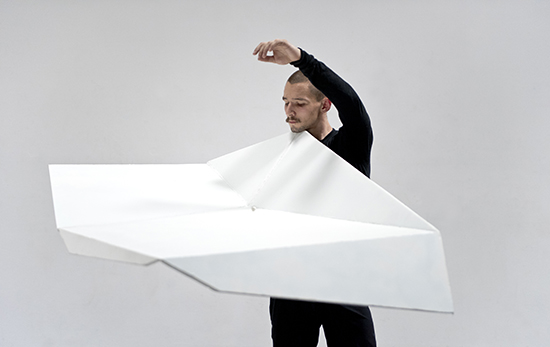
James Batchelor, Deepspace, Dance Massive 2017
photo Gregory Lorenzutti
James Batchelor, Deepspace, Dance Massive 2017
James Batchelor, Deepspace
The Australian Antarctic Arts Fellowship provides artists with a unique translation opportunity. Artists with a non-science background are offered a place on a government icebreaker, and the chance to experience Antarctica. The challenge for the artist is to communicate this unique experience to others.
Last year choreographer James Batchelor explored the Southern Ocean, and Deepspace is his response. This is a work that reflects more on themes of confinement and restriction than on frigidity and vastness. The long warehouse space in North Melbourne, with its white walls and polished concrete floor, is reminiscent of the closed world of a ship’s hold. Sound designer Morgan Hickinbotham sits with his laptop on a mezzanine at the far end of the warehouse, overlooking the performance space. You can almost imagine that he’s on a ship’s bridge.
Batchelor and Chloe Chignell run their hands along the walls, dodging audience members, emphasising the fact of confinement. There are several passages depicting the constant heave of the ship, and there is a strange erotic ritual in which Batchelor stands over the kneeling Chignell, both holding large white polygonal sculptures. Is this a comment on boredom as aphrodisiac?
What is perhaps missing in this translation is a sense of the unseen immensity beyond the wall of the hull. I thought I saw it once, when Chignell was standing on Batchelor’s shoulders against a wall, wiggling her fingers. It looked for a moment like a black fissure in a glittering wall of ice.
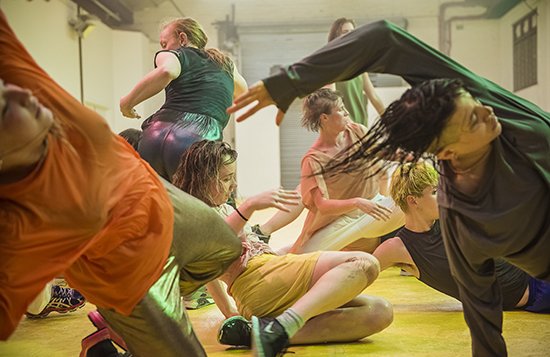
Deep Sea Dances, Rebecca Jensen and ensemble, Dance Massive 2017
photo Gregory Lorenzutti
Deep Sea Dances, Rebecca Jensen and ensemble, Dance Massive 2017
Rebecca Jensen, Deep Sea Dances
Seventeen dancers sweep through a warehouse space lit by streetlights outside the clerestory windows, surging and then drifting, rising and then sinking, caught up in a delicate pattern of ebb and flow. There are beautiful, quick, undulant phrases, like “grinding water” or “gasping wind,” as Wallace Stevens has it; and there are moments of poised calm.
Who is this amazing choreographer and what has she done with Rebecca Jensen? It is early 20th century dance innovator Doris Humphrey and the piece is Water Study (1928). And whatever you may think of Jensen’s own work, it is surely a minor bit of brilliance to begin the evening with a revival of this early experimental masterpiece. The Dance Massive festival can sometimes feel like a place where dance falls out of dialogue with its past and embraces pure contemporaneity. Wouldn’t it be a good thing to see more independent artists presenting recreations alongside their own work?
This question of the relationship of contemporary dance in Australia to its history feels like an urgent one. It’s a question which is raised also in Shian Law’s Vanishing Point and Martin Hansen’s If It’s All in My Veins in the Dance Massive program. Perhaps we are approaching a turning point? It would not be a bad thing if we saw a new enthusiasm for the lost worlds of avant gardes past.
The other thing to note about Water Study is how compact it is. Performed by Jensen and her team it runs for less than 10 minutes. There’s more than one work in this year’s festival that would benefit from cutting and condensing, dances where a relatively small amount of material is padded with extraneous business and repetition, drawing out to tedious length something that might have been an effective 10 or 15-minute show.
This of course is not just a problem for independent choreographers; it is a problem for presenters and commissioning partners. Why are there no double or triple bills in the festival? Why is the independent sector obsessed with long works?
In any case, Jensen should be applauded for smuggling in a second piece. (No mention is made of Humphrey in the program notes or on the festival website, perhaps because the copyright still has eleven years to run.) But Jensen’s own piece is nonetheless longer than it needs to be.
Where Water Study can be read as a graceful translation of the way water moves in large-scale flows, in Deep Sea Dances we see the competitive interactions and chaotic dynamics in undersea ecosystems. This is a fine enough idea and leads to some interesting improvisations, and Jensen’s nostalgia-tinged sea-punk aesthetic is not entirely unappealing, but there’s no reason for inflating this piece beyond half an hour.
–
Dance Massive 2017: Victoria Hunt, Tangi Wai…The Cry of the Water, Meat Market, 14-18 March; József Trefeli and GáborVarga, Creature, Carlton Baths, 17-19 March; Rhiannon Newton, Bodied Assemblies, Dancehouse, 14-17 March; James Batchelor, Deepspace, Meat Market, 20 March; Rebecca Jensen, Deep Sea Dances, Meat Market, Melbourne, 22-26 March
RealTime issue #138 April-May 2017






